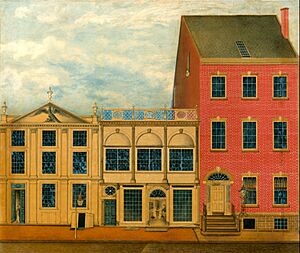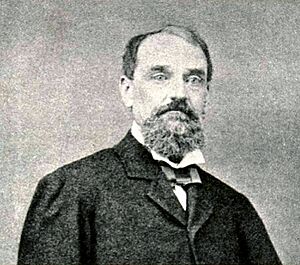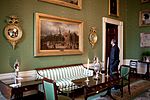Duncan Phyfe facts for kids
Quick facts for kids
Duncan Phyfe
|
|
|---|---|
 |
|
| Born |
Duncan Fife
27 April 1770 Abernethy and Kincardine, Scotland
|
| Died | 16 August 1854 |
| Occupation | Cabinetmaker, businessman |
| Years active | 1792–1847 (55 years as an independent cabinetmaker) |
| Spouse(s) | Rachel Louzada (ca. 1781-1851) |
| Children | Michael (1794-1836)
Mary (1795-1870) William (1799-ca. 1802) Eliza (1801-1890) William (1803-1875) Edward (1808-1887) James (presumably dead by 1814) Isabella (ca. 1814-1841) James Duncan (1814-1887) |
Duncan Phyfe (born April 27, 1770 – died August 16, 1854) was one of America's most famous furniture makers in the 1800s. He didn't invent new furniture styles. Instead, he took popular European designs and made them his own. His unique touch made him a leader in the Neoclassicism style in the United States. He greatly influenced many other American furniture makers.
Contents
Life of a Master Cabinetmaker
Early Life and Moving to America
Duncan Phyfe was born Duncan Fife near Loch Fannich in Scotland. When he was about 14, in 1784, his family moved to Albany, New York. There, he began learning how to make furniture as an apprentice. An apprentice is someone who learns a skill from a master craftsman.
In 1791, he moved to New York City. The next year, he joined the General Society of Mechanics and Tradesmen. This was an important step for a craftsman. By 1793, he was listed as a "joiner" in New York. A joiner makes wooden items by joining pieces of wood.
Starting His Own Business
By 1794, he called himself a "cabinetmaker." This means he made fine furniture. He also changed his name to Phyfe. He opened his own business in 1794. His first shop was on Broad Street. Later, he moved to Partition Street. This street was later renamed Fulton Street. He stayed there for the rest of his career.
Duncan Phyfe started as a poor immigrant from Scotland. But he became rich and famous. He achieved this through hard work and great talent. He also had support from wealthy customers. These customers were called patrons. He made furniture for some of the richest families in the country. His clients lived in New York, Philadelphia, and the American South. He was very popular there.
Phyfe's Unique Style
During his lifetime, people called him the "United States Rage." This meant he was incredibly popular. Even today, he is America's most well-known cabinetmaker. He became known for making very high-quality, luxurious furniture.
His personal style was special. It featured excellent proportions, balance, and symmetry. His designs were also very simple and elegant. This style became known as the "New York local style." Many young workers learned this style from him. They either worked in his shop or copied his designs. This helped spread his unique way of making furniture.
Demand for Phyfe's work was highest between 1805 and 1820. He remained a top furniture maker until 1847. That's when he retired at age 77. For a while, his work was almost forgotten. But in the 1920s, his designs became popular again. Many furniture companies started making copies of his pieces.
Different Furniture Styles
Phyfe made furniture in many different Neoclassical styles. Neoclassical means "new classical." This style was inspired by ancient Greek and Roman art. His early furniture showed influences from British designers like Thomas Sheraton and Thomas Hope. He also worked in the Regency, Federal, and Empire styles. Later, he created simpler designs in the Grecian plain style.
Between 1837 and 1847, Duncan Phyfe worked with his two sons, Michael and James. Their business was called D. Phyfe & Sons. After Michael passed away, it became D. Phyfe & Son. During this time, Phyfe faced a big challenge. New furniture styles were becoming popular. These were called "historical revival styles." They copied older styles like Baroque, Gothic, and Rococo.
The Phyfes stuck to their classic Neoclassical style. They didn't really adopt these new trends. In 1840, a customer said the Phyfes were "behind the times in style."
Retirement and Legacy
Duncan Phyfe and his son James closed their family business in 1847. They had been in the furniture trade for 55 years. They held an auction to sell the furniture left in their warehouse.
It can be hard to know for sure which furniture pieces Phyfe made. This is because he rarely signed his work. Also, many other people copied his designs. Duncan Phyfe is buried at Green-Wood Cemetery in Brooklyn, New York.
Famous Exhibitions and Collections
On October 15, 1922, the Metropolitan Museum of Art held a special show. It was called "Furniture from the Workshop of Duncan Phyfe." This was the first time an art museum had an exhibition just for one furniture maker.
Ninety years later, another big show about him opened. It was from December 20, 2011, to May 6, 2012. This exhibition was called "Duncan Phyfe: Master Cabinetmaker in New York."
Another exhibition took place at the Museum of Fine Arts, Houston. It ran from June 24 to September 9, 2012.
You can see Duncan Phyfe's furniture in many important places. These include the White House Green Room and Millford Plantation. His furniture is also in many museums and private collections.
See also
- Charles-Honoré Lannuier, another reputable cabinetmaker





